
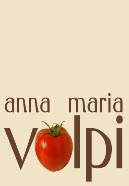



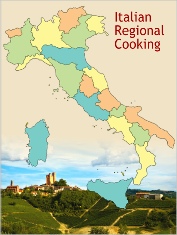


JOIN NOW
our Italian Cooking
Newsletter
our Italian Cooking
Newsletter

Publication or use of pictures, recipes, articles, or any other material form my Web site, on or off-line without written permission from the author is prohibited. If you would like to use my articles on your Web site or in your publication, contact me for details. Avoid infringing copyright law and its consequences: read the article 7 Online Copyright Myths by Judith Kallos
Read our
DISCLAIMER and
PRIVACY POLICY
before using
our site
-------------------
Linking Policy
Advertise with us
DISCLAIMER and
PRIVACY POLICY
before using
our site
-
Advertise with us
Copyright © 2003 - 2011 Anna Maria Volpi - All Rights reserved.
Anna Maria's Open Kitchen Site Map
site map
recipes
policies
about us
Some More Hot Topics You'd Like to See adv.




Anna Maria Suggests
Extra-
The Best Selection of Italian Extra-
Buy from the source Authentic Aged Traditional Balsamic Vinegar from Italy
Sicily, Apulia, Lazio, Liguria, and More...The Best Selection of Succulent Italian Olives Oil
Infused Extra-
Spice up your dishes with Infused Flavored Italian Extra-
The Food of Carnival
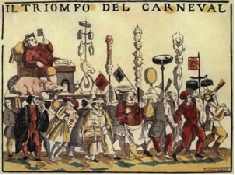
Saturnalia for the Romans included long and complex rites dedicated to sowing. Banquets, exchanges of presents, and sweets characterized these celebrations, which included servants acting as their masters, and a slaves being crowned as kings. Lupercalia marked the end of the Roman year and was celebrated with dancing and singing in the streets. Historians believe that these celebrations influenced Carnival.
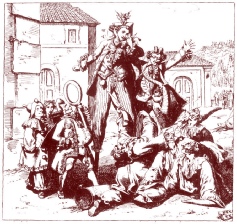
Masks during the Roman Carnival
Engraving by B. Pinelli, circa 1830.
Engraving by B. Pinelli, circa 1830.
For centuries, Rome was the headquarters of Carnival. Many popes have been great supporters of the public celebrations, the horse rides, the exhibitions, and the parades. During the Renaissance, the festivities, sponsored by the Pope and the noble Roman families, acquired political prominence. Thousands of people would travel from all over Europe to attend. The Palio was a famous horse race without jockeys, taking place along the Via del Corso. The race became a competition for the best horses. The victory would culminate in a large public banquet and food distribution. The Palio was abolished in 1884 after an accident occurred in front of Queen Margherita.
Carnival has very ancient origins. It is believed to have originated in Roman times when Saturnalia, the Saturn festival, and Lupercalia, the feast of the full moon, were celebrated.
Traditional in Roman Catholic countries, Carnival is not celebrated or even known in many countries of other faiths. The Carnival Season is a holiday period during the two weeks before the traditional Christian Lent, when the rigors of 40 days of fasting and sacrifice begin. In fact, the origin of the word “Carnival” comes from the Latin “carne-levare ,” literally "to remove the meat" or "stop eating meat." The celebration of Carnival ends on Mardi Gras (French for "Fat Tuesday").
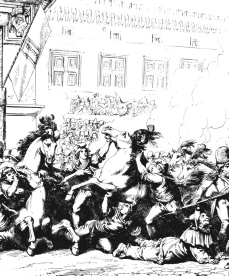
The city was occupied by Napoleon in 1797, and this actually ended the Repubblica Serenissima, “The Most Serene Republic.” After Venice became part of the Austrian Empire, the celebration of Carnival was halted and restarted only in the 1970s. Today, Venetians have reinvented the ancient masks and costumes in a style that melts together the dress styles from the Middle Ages through the 1700s. The result is splendid precious elegant dresses in silk, gold, silver, and lace, wigs, and since the masks cover people’s faces, everybody can feel free to dance and sing in public without being recognized.
Horse Race during the Roman Carnival
Engraving by B. Pinelli, circa 1830.
Engraving by B. Pinelli, circa 1830.
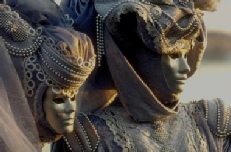
The carnival of Venice was first recorded in 1268. It was unruly, with parades and Pamplona style bull chasing games. The use of masks to cover faces made it even more transgressive, and the Mascareri, the mask-makers had a special position in Venice. Everyone could wear a mask during the carnival without the barriers of gender and social status.
What is Carnival after all, other than excess and the transgression before the sacrifice? And the practiced and desired transgression was of course related to the abundance of food. The gastronomy of Carnival rich in fats and sweets. Traditional dishes in most regions of Italy include gnocchi, lasagna and tortelli.
Nowadays, many traditions have vanished or changed, but fried pastries are still common in Fat Tuesday cookery. Spoonfuls of dough fried in oil take the shape of small balls in Frittelle or Castagnole.
However, the most famous carnival fritters are ribbons of sweet pasta fried and covered with sugar or honey. These fritters are familiar all over Italy, where they assume many different names—including Frappe, Frappole, Sfrappole, Flappe in central Italy, Cenci (“tatters”) or Donzelli (“young ladies”) in Tuscany, Crostoli (“crusts”) or Galani in Veneto, Lattughe (“lettuce”) in Romagna, Nastri delle Suore (“ribbons of the nuns”) in Emilia, Bugie (“lies”) in Piemonte, and Gigi in Sicily. Is there another dish with so many names?
Nowadays, many traditions have vanished or changed, but fried pastries are still common in Fat Tuesday cookery. Spoonfuls of dough fried in oil take the shape of small balls in Frittelle or Castagnole.
However, the most famous carnival fritters are ribbons of sweet pasta fried and covered with sugar or honey. These fritters are familiar all over Italy, where they assume many different names—including Frappe, Frappole, Sfrappole, Flappe in central Italy, Cenci (“tatters”) or Donzelli (“young ladies”) in Tuscany, Crostoli (“crusts”) or Galani in Veneto, Lattughe (“lettuce”) in Romagna, Nastri delle Suore (“ribbons of the nuns”) in Emilia, Bugie (“lies”) in Piemonte, and Gigi in Sicily. Is there another dish with so many names?
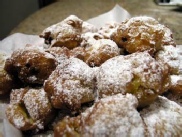
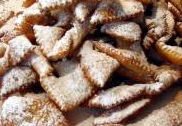
Modern Masks in Venice
Frittelle
Frappe
Copyright © Anna Maria Volpi - All Rights reserved.